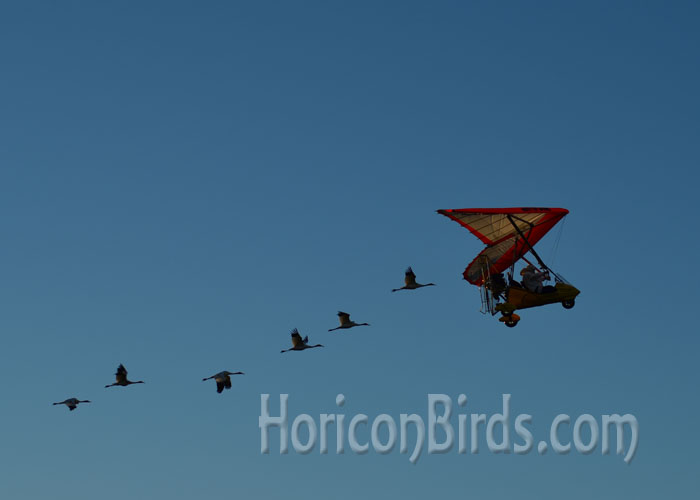|
Pondering the end of ultra-light whooping crane migrations
by Pam Rotella
24 January 2016
HoriconBirds.com
So here I sit, in a coffeehouse I found following Operation Migration's flyover stops, pondering the end of the ultra-light guided migrations and the fate of whooping cranes.
I'd hoped one day to make the trip to Florida to see the birds arrive, and witness the big annual gathering of Operation Migration's many fans there. Instead, I'll have to be happy with having seen them off in Wisconsin, on what was to become their last guided migration. The short notice of the program's end and the bad economy mean that I'll miss this one last chance to see their final journey.
Yesterday, Operation Migration announced the US Fish and Wildlife Service's decision to end ultra-light guided whooping crane releases. Describing a part of their Whooping Crane Eastern Partnership meetings, Joe Duff wrote in the group's 23 January "In the field" entry:
"... During the WCEP meetings, the issue of technique evaluation was not addressed. Instead we focused on ways to keep released birds with adult role models for as early, and as long as possible.
"On Friday after the WCEP meetings, the Guidance Team gathered in a small boardroom at ICF. Pete Fasbender spoke first and after a long presentation about the future of the EMP and OM's contribution, he told me that the decision was final. There will be no more aircraft led releases."
I can't help but question that decision. After following the whooping crane reintroduction programs for several years, It became apparent to me that the most successful whooping crane release method has been the ultra-light guided program. The USFWS Vision statement has criticized the low rate of reproduction, but there are many parts to that equation.
At the very least, birds reintroduced with the ultra-light method are migrating, have a good chance of surviving to adulthood, and mate with their own species to produce some chicks. Alternatively, "Direct Autumn Release" or DAR whoopers at Horicon seem to think that they're sandhill cranes, and they mate with sandhills. They also have had difficulties knowing when and how to migrate, and often are killed by natural predators before they can leave Wisconsin. Also, the non-migratory flocks in Louisiana and Florida don't migrate (which was rare for whooping cranes before they nearly went extinct), and they often become prey for bobcats.
It's a good idea to improve reproduction rates of whooping cranes, but normally methods would be tested to make that happen before giving up the one program that shows results. Once alternative methods are proven to work as well as, or ideally slightly better than, the ultra-light program, that's when you'd phase out the ultra-light program -- not before you have any viable alternative at all.
I often wondered if the real goal of DAR and the non-migratory flocks was to find a cheaper, easier way of achieving the same results as the ultra-light program. Cheaper and easier is good, if you can find it, but you can't always force the easy way to yield the results you need. Then there's the issue of talent. If Operation Migration's team breaks up and its members retire or pursue other careers, how will another team be found when people finally decide that they're needed? Operation Migration developed many good protocols to keep the birds and pilots safe, and the learning curve would be a big one for any subsequent ultra-light programs.
But then I remember. The only real question here is, will the species survive?
That brings the one naturally wild flock into the picture, flying between Wood Buffalo National Park in Canada and Aransas National Wildlife Refuge in Texas. The purpose of the eastern flock was to provide an alternative population, should the Wood Buffalo flock suffer a great loss or extinction from natural disasters, disease, or environmental pressures. Already droughts and competition for water by humans in Texas have put pressure on the natural whooping crane flock. A hurricane or oil / chemical spill in the gulf could theoretically wipe out the entire Aransas population.
And so while not the only hope of the species today, the reintroduced eastern flock is important. I had confidence that the eastern migratory flock would survive, if more birds were introduced until it became large enough to sustain itself. Now... I'm not sure.
FWS can talk about programs to help whooping crane reproduction rates, but I don't have confidence in yet another experimental program that hasn't been tested or even introduced yet. How many past whooping crane programs have failed or are currently failing after years of good efforts, because they happened to be another good idea that didn't pan out in the real world?
The results of the ultra-light program may be small so far, but at least they're moving in the right direction, ultimately giving the desired outcome of wild-hatched chicks. So far, I haven't seen a competing program with returns as promising.
Someday when I have more time, I'll put together a slideshow of my ultra-light program pictures. I hope this collection will grow as I continue to visit Horicon, Necedah, and White River Marsh through the years, and continue to see whooping cranes there. Until then, below is Joe Duff leading the birds on the start of the last ultra-light guided migration, 30 September 2015...

|
|
THE LAST ULTRA-LIGHT GUIDED WHOOPING CRANE MIGRATION BEGINS: Operation Migration co-founder Joe Duff begins the 2015 guided migration at White River Marsh with six whooping crane colts. Photo by Pam Rotella
|
All original content including photographs © 2015-16 by Pam Rotella.
|